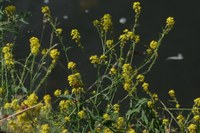Rapid evolution aids spread of exotic plant species

The Pyrenean rocket (pictured) is a harmless plant, but some exotics can become a real plague even after a period of unproblematic presence in a non-native environment. | Photo © Katrien Vandepitte
The Pyrenean rocket (Sisymbrium austriacum subsp. Chrysanthum) is a plant that grows in the mountains of southern Europe and is particularly prevalent in the Pyrenees. The species was first reported in Belgium – 1,200 kilometres north of its native range – in the first half of the 19th century.
Seeds from the plant were most likely introduced alongside the wool industry in and around Verviers. The Pyrenean rocket took root on the banks of the River Vesdre in Verviers and later spread across the Meuse basin towards the Netherlands.
The colonization history of the Pyrenean rocket is well documented, explains postdoctoral researcher and corresponding author Katrien Vandepitte (Plant Conservation and Population Biology Research Group):
“We found dried specimens of the Pyrenean rocket in herbaria from the 19th and 20th centuries and were able to isolate DNA from these samples. We then compared this DNA with the genetic profile of contemporary samples from Belgium and the Pyrenees. This gave us a unique opportunity to reconstruct when and how an exotic plant species genetically adapted to a new environment.”
“When we looked at the genetic evolution of the Pyrenean rocket, we found the greatest divergences in a set of genes that regulate flowering time, an important plant fitness trait. When we compared current individuals taken from our region and the Pyrenees, both grown under Belgian conditions, the Belgian variant bloomed later.”
“Our DNA analysis shows that the Belgian variant genetically adapted quite rapidly – in about 20 generations. This very likely helped the plant to survive and spread here.”
“Our findings are important because until now evidence supporting the hypothesis that exotic plants can spread after a period of rapid genetic adaptation has been very scant,” says Dr. Vandepitte.
The results also suggest that we should be wary of ‘latent’ non-native plant species. “These plants can be present in small numbers for years before spreading as a result of genetic adaptation. The Pyrenean rocket is a harmless plant, but some exotics can become a real plague. And this can occur even after a period of unproblematic presence in a non-native environment.”
The researchers’ findings were published as the cover story in the May issue of the journal Molecular Ecology.
Ilse Frederickx
Media Contact
All latest news from the category: Ecology, The Environment and Conservation
This complex theme deals primarily with interactions between organisms and the environmental factors that impact them, but to a greater extent between individual inanimate environmental factors.
innovations-report offers informative reports and articles on topics such as climate protection, landscape conservation, ecological systems, wildlife and nature parks and ecosystem efficiency and balance.
Newest articles

Machine learning algorithm reveals long-theorized glass phase in crystal
Scientists have found evidence of an elusive, glassy phase of matter that emerges when a crystal’s perfect internal pattern is disrupted. X-ray technology and machine learning converge to shed light…

Mapping plant functional diversity from space
HKU ecologists revolutionize ecosystem monitoring with novel field-satellite integration. An international team of researchers, led by Professor Jin WU from the School of Biological Sciences at The University of Hong…

Inverters with constant full load capability
…enable an increase in the performance of electric drives. Overheating components significantly limit the performance of drivetrains in electric vehicles. Inverters in particular are subject to a high thermal load,…





















